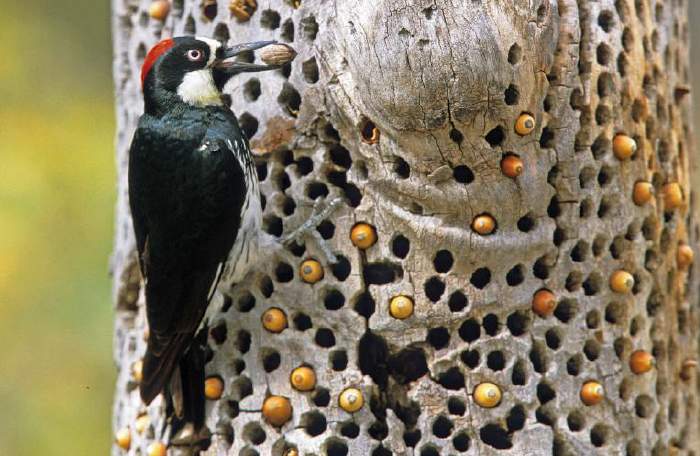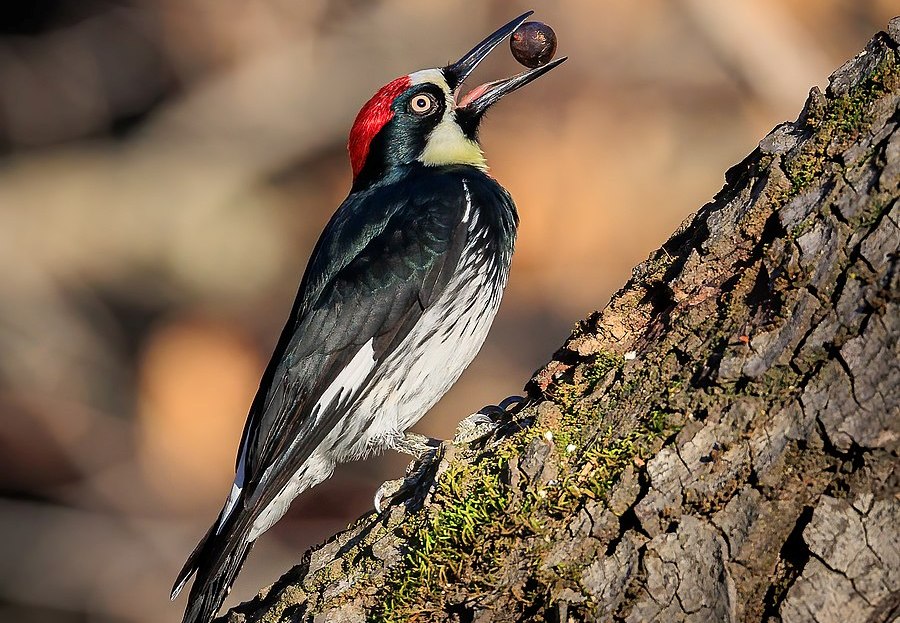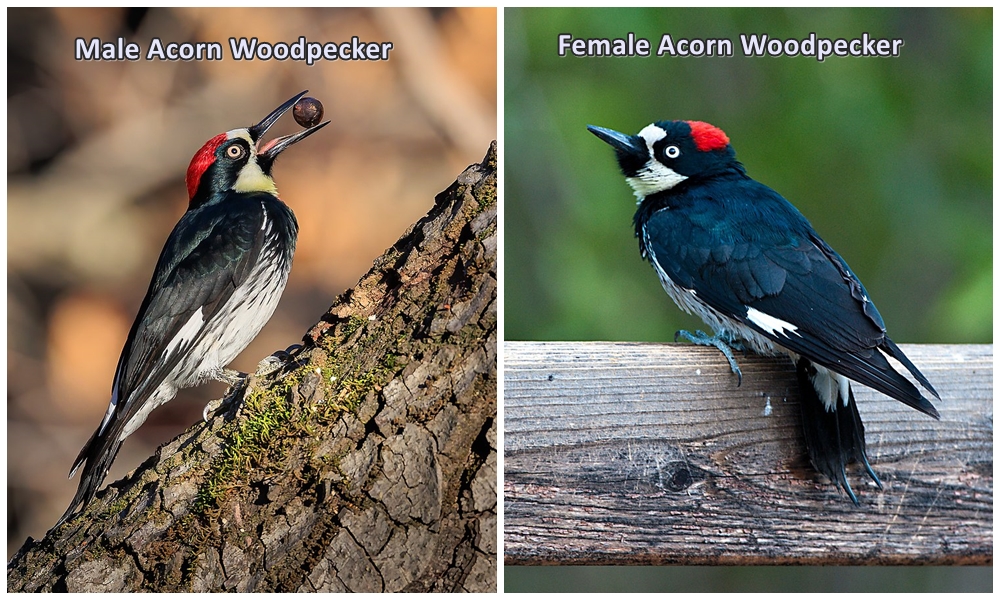Acorn Woodpecker call is chattering and laughing, including squeaky ik-a,i k-a, ik-a contact notes, mocking yak-a, wak-a or wick-a, nasal waaayk, short, and longer ahrr-ah-ah, rising quaay, harsh rack-up, rack-up or ratchet, ratchet, loud ja-cob, ja-cob, ja-cob, and a trilling dddddrridrr or higher-pitched dddrreeeerr. Acron woodpecker alarm calls include squealing notes and scratchy, drawn-out karrit, krrrrrit, or krrrrit-kut. Hence, birds cawing urrrk during disputes. If the woodpecker calls while clinging upright above a horizontal branch, its deep bow brings its head to the level of its feet.
Probably because it has such a well-developed voice, the Acorn Woodpecker seems to beat tattoos with its bill less often than many other woodpeckers, at least in Central America. Acorn Woodpeckers are loquacious, often calling loudly rack-up rack-up, Y-I-Yrack-up, and similar notes in a strong, deep voice. When several rest close together, they communicate in lower tones. Acorn woodpecker drumming is a little slow, but accelerating rolls of 15–20 strikes sometimes interspersed with single knocks and taps.

Acorn woodpecker (Melanerpes formicivorus) is a medium-sized woodpecker of about 21–23 cm in length. It is strikingly patterned. Bold facial markings are often described as ‘clownish’: white or yellow iris, gray or black orbital ring, cream forehead connected to creamy cheeks and throat by the narrow transoral band; black chin and nasal tufts form a broad black patch at the base of the black bill.
The chest is black, the breast is white, and the white flanks are streaked black. The belly and under tail coverts are mostly white, sometimes slightly streaked. Acorn Woodpecker mantle, back, and tail are glossy blacks, with a white rump and primary patch obvious in flight. In his social habits, the bird seems to represent a further development of the situation exemplified by the golden-naped woodpecker.
Both sexes differ slightly. The male has an attractive red crown, and the female has red only on the nape or is absent, depending on race. The young bird has a red or orange crown resembling an adult male; black areas are dull, and the iris is dark. The young nourished largely on insects caught in the air by the adults and carefully prepared before being given to them.

The acorn woodpecker is locally common. But the overall population is probably stable, though local increases were noted as well as declines due to the loss and degradation of oak woods. Acorn Woodpeckers prefer open stands of oaks, pines, and other trees, or else the woodland’s edge, to the interior of heavy, unbroken forests. Throughout the year, they live in parties of three to six or possibly more, which are apparently family groups, in which great concord seems to prevail. According to habitats, it is found in temperate and tropical, dry and humid woodlands (particularly oak and oak-pine). Also forest edges and clearings with scattered trees, wooded suburbs, and gardens.
The woodpecker range is in North and Central America. Disjunct from Western USA (isolated population in Edwards Plateau, Texas) to Colombia Mostly resident, a few migrate or wander north and east when acorn crops fail. It is mainly found at mid-elevations, from sea level in California to 3400 meters in the Andes. In northern Central America, it occurs from near sea level in the pine-oak woods of British Honduras to 9000 feet in Guatemala, but it is found chiefly above 5000 feet. In Costa Rica, it ranges from about 3,000 to 10,000 feet.
Taxonomy and variation: There are seven races: formicivores (Arizona, New Mexico, W Texas to SE Mexico); bairdi (NW Oregon to N Baja California), the smallest race proposed as distinct species, Baja Woodpecker’; albeolus (S Mexico into Belize and NE Guatemala) throat very pale, plain below; lineatus (Guatemala.

El Salvador, N Nicaragua, Honduras,) profoundly streaked below; the primary patch is large; the striatipectus (Costa Rica, Nicaragua, and West Panama) and throat are bright yellows, the primary patch is a bit small; the flavigula (Andean Colombia) closely marked below; the male has reduced red on the crown, and the female lacks red.
Food and foraging Omnivorous: the woodpecker is taking flying insects, fruit, berries, and seeds. Insects caught on the wing form an important part of the Acorn Woodpeckers diet. Expert flycatchers are especially active in the pursuit of flying insects in the evening twilight.
When acorns ripen, these woodpeckers often pluck a twig bearing one or more and carry it to a convenient branch or stub, where they place an acorn in a cranny and peck it to pieces with the bill.
Some populations (mainly in N) harvest and store acorns in multi-hole ‘granaries’ made in tree trunks and buildings. Families create and share sap wells and visit sugar-water feeders. And of all the woodpeckers, the most interesting are the Acorn Woodpeckers, who are so strikingly attired, so sociable, so loquacious, and so restlessly active.
Like other members of the family, acorn woodpeckers sleep in holes that they habitually carve in trees. These holes have the same form as their nest holes. More than a few individuals may lodge together, as in Tripsurus and Picumnus, though solitary sleeping seems to be more usual in the family as a whole.
Frequently Acorn Woodpeckers retire very late in the evening after most other diurnal birds have gone to roost. However, they are not consistent in this, and sometimes they seek their dormitory early, as seems to be the more usual practice in the woodpecker family. In the morning, they often linger in their snug chambers long after other birds have become active, as is typical of woodpeckers. But in this, too, they are not consistent.
Related Reading: The Facts of Powerful Woodpecker







